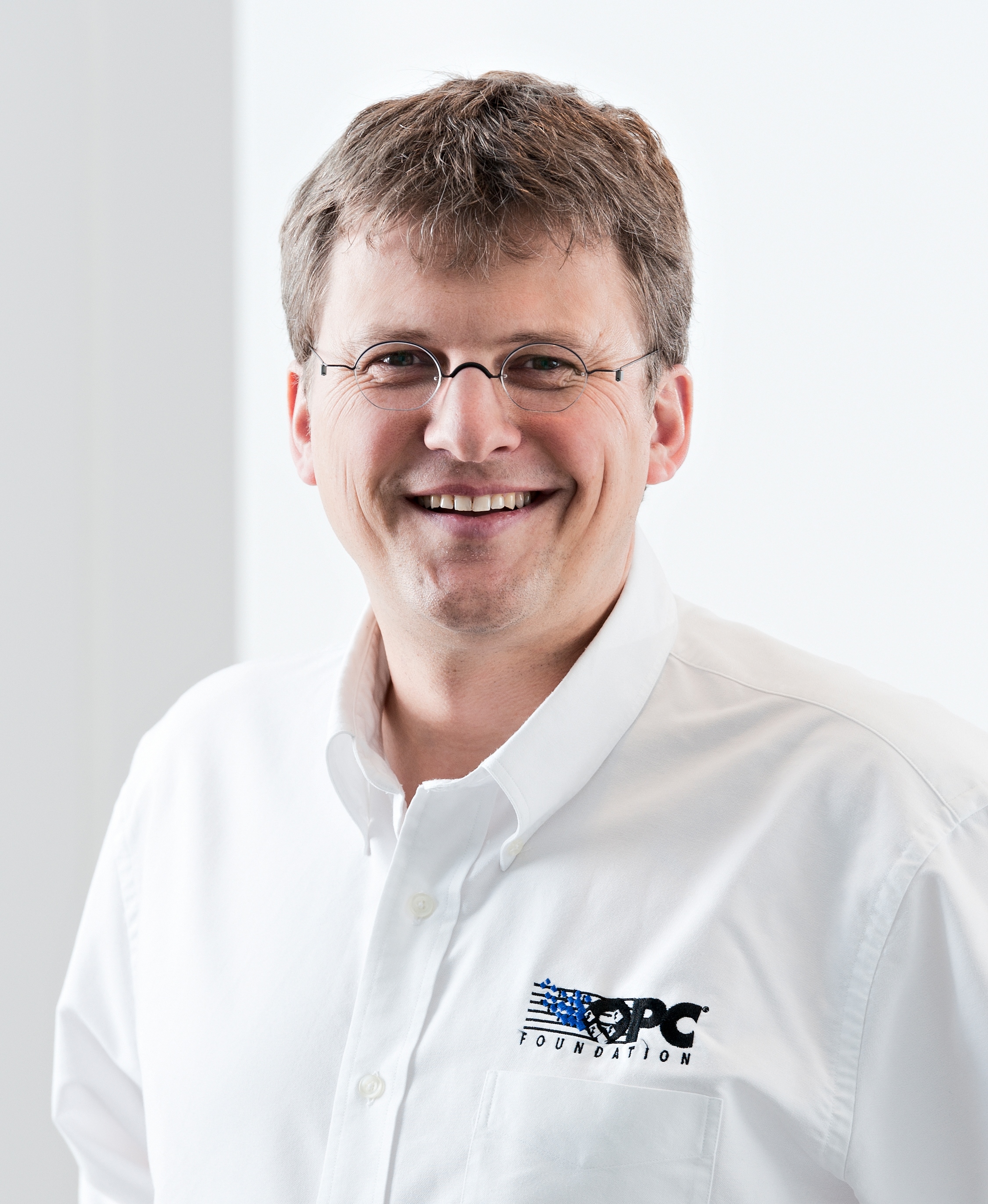
by Gary Mintchell | Apr 24, 2015 | Automation, Internet of Things, Manufacturing IT, Networking, News, Operations Management, Organizations, Standards, Technology
 News about further adoption of OPC (www.opcfoundation.org) continued to flow from the recent Hannover Fair (Messe) in Germany. Things had gone dark for a period of time from the Foundation. This has changed over the past couple of weeks as the communication technology picks up momentum.
News about further adoption of OPC (www.opcfoundation.org) continued to flow from the recent Hannover Fair (Messe) in Germany. Things had gone dark for a period of time from the Foundation. This has changed over the past couple of weeks as the communication technology picks up momentum.
The Platform Industrie 4.0 (I4.0) announced at Hannover Messe 2015 a reference architecture model for Industrie 4.0 (RAMI 4.0). RAMI 4.0 is a unified architecture model where use-cases, standards etc. for I4.0 are necessary. In RAMI 4.0 I4.0 components are defined in their structure and functioning. Thus it enables cross-company networking and integration across value-added networks. Where meaningful, RAMI 4.0 builds on existing and relevant standards.
The Platform Industrie 4.0 trade organizations BITKOM (IT), VDMA (Mechanical Engineering) and ZVEI (Electronics) together collected and analyzed necessary or relevant standards for RAMI 4.0 in technically oriented working groups. In the category “Communication Layer“ the OPC UA (IEC 62541) standard was thoroughly examined and deemed adequate for RAMI 4.0 as the one and only confirmed.
“Companies like ThyssenKrupp are implementing Industrie 4.0 today. The availability of established communication protocols is mission critical for such a timely implementation, OPC-UA is here the best example,” said Dr Achatz head of technology at ThyssenKrupp AG.
“We are proud the Platform Industrie 4.0 thoroughly analyzed OPC UA in the category “Communication Layer” and confirmed its relevance as the only standard for the reference architecture model for Industrie 4.0,” said Thomas J. Burke, President and Executive Director of the OPC Foundation. “This shows that the OPC Foundation is on the right track with our approach of secure, safe, manufacturer- and platform independent communication for heterogeneous systems by means of OPC UA to become a global data exchange standard for Industrie 4.0 and the Internet of Things.”

by Gary Mintchell | Apr 22, 2015 | Automation, Data Management, Internet of Things, Manufacturing IT, Networking, News, Operations Management, Organizations, Software, Standards, Technology
 I have been writing about some open source initiatives with OPC UA. I think it’s cool and long overdue that there is so much happening in the OPC world lately. See these:
I have been writing about some open source initiatives with OPC UA. I think it’s cool and long overdue that there is so much happening in the OPC world lately. See these:
Open Source OPC UA Development
Open Source OPC UA for Manufacturing
Last week at Hannover, the OPC Foundation announced several items—including the promotion of Stefan Hoppe to Vice President of the Foundation (pictured). Another one deals with an open (sort of) source initiative designed to broaden the appeal of OPC outside of the industrial automation community.
OPC Announces “OPC UA Open Shared Source” Strategy
The OPC Foundation announced that the OPC Unified Architecture (OPC UA) specifications and technology will be made available to companies, consortiums, and end users without requiring membership in the OPC Foundation. The OPC Foundation is implementing an “open shared source” strategy to facilitate widespread adoption of the technology beyond industrial automation.
OPC UA provides a complete solution for information modeling allowing consortiums and vendors to plug in their simple or complex information models directly into OPC UA and take advantage of all of the OPC UA SOA allowing generic devices and applications to seamlessly share information.
The OPC Foundation open shared source strategy provides developers a quick jump start on the technology enabling prototyping projects without any barriers.
The OPC Foundation vision of interoperability providing the best specifications, technology, certification and process is the core of this open shared source strategy for the technology and specifications. The open shared source will be hosted on open source collaboration community work space. The OPC Foundation OPC UA stacks available to the OPC Foundation members will be under RCL license, allowing OPC Foundation members to build the highest quality OPC UA enabled products and then be able to certify the products through the comprehensive OPC Foundation certification and interoperability programs.
Stefan Hoppe, OPC Foundation Vice President, commented that “Adoption of OPC standards in industrial automation and specifically reaching out to other domains requires new ways of thinking to evangelize and increase awareness about the OPC Technology. OPC Unified Architecture is becoming the dominant infrastructure and information modeling architecture for the Internet of things and Industry 4.0, and these initiatives require complete transparency and open this about the technology to be a core part of their infrastructure.”
Continuing the Conversation
Andy Robinson pointed to a neat little app on OPC on YouTube. I replied and that led to a cool conversation between Andy and Rick Bulotta of ThingWorx. Here is what a nice little conversation can happen on Twitter. I’d like to invite more of these.
Andy Robinson @archestranaut @garymintchell re OPCUA, thought you might be interested in this. It’s a small start but the vision is great! http://ow.ly/LWdXq
Then Rick Bullota chimed in:
Rick Bullotta @RickBullotta why introduce #MQTT into the mix? it is a weak subset of OPCUA (no metadata, RPC, discovery)? #IoT
Andy Robinson @archestranaut 100% for typical in the building plant floor apps. But for weak or expensive connectivity may be better.
Rick Bullotta @RickBullotta living with “all of the above” here @Thingworx. MQTT is more like OPC (actually, NetDDE) than OPCUA.#IoT
Andy Robinson @archestranaut also agree #mqtt maybe not ideal for commands as would probably require Qos2, not a huge deal…
Rick Bullotta @RickBullotta btw, I think it’s quite cool what you did though! nice work!
Andy Robinson @archestranaut not my work. Someone else.
Andy Robinson @archestranaut but I do think the basic idea of accepting not many new #IOT device will speak UA out of box leads us to .. . think about how we might integrate at least a subset of critical info into our already setup SCADA systems.
Andy Robinson @archestranaut I don’t suspect folks like Thingworx are looking to supplant traditional SCADA. At least doesn’t seem logical
Rick Bullotta @RickBullotta we’re already doing this with @ThingWorx via OPC/OPCUA, historians, HMI APIs, databases, and so on.
Andy Robinson @archestranaut which is why you will be fine while other “similar” offerings will disappear on the low end
Rick Bullotta @RickBullotta correct. connecting, augmenting integrating and expanding their reach, whether within the plant or beyond.
Rick Bullotta @RickBullotta been there, done that, twice. 😉 I also founded Lighthammer (now SAP MII).
Andy Robinson @archestranaut nice to have a more civil convo after the last mini-twitp*** of about a month ago with others. 🙂

by Gary Mintchell | Apr 21, 2015 | Automation, Data Management, News, Operations Management, Security, Technology
 [ Updated] Wherever I go and with whomever I speak, file security in this age of Internet of Things, connected devices, collaboration, and open access is top priority. I just heard about this new company and technology who promises a higher level of file security.
[ Updated] Wherever I go and with whomever I speak, file security in this age of Internet of Things, connected devices, collaboration, and open access is top priority. I just heard about this new company and technology who promises a higher level of file security.
FinalCode Inc., enterprise file security for a connected world, announced global availability of its enterprise-grade file security. By combining a patented approach to make file security processes seamless with the ability to remotely delete files on popular devices, FinalCode allows organizations to gain strong file protection to ensure sensitive information remains protected on devices, content management systems, cloud storage and collaboration channels.
According to Privacy Rights Clearinghouse, nearly 305 million records have been leaked in the U.S. for the past five years due to unintended disclosure, hacking or malware, insiders, and lost or discarded mobile and stationary computing devices. In a connected world of personal and mobile computing, cloud applications, dynamic collaboration and cyberattacks, organizations have limited means available to protect sensitive shared files inside or outside a corporate network, which presents tremendous exposure to data leakage, compliance, reputation and liability risks. One significant challenge is applying strong file security, as sensitive and regulated files are sent, shared and forwarded to unintended or unauthorized users outside trusted computing and content sharing environments. Worse are confidential files inconspicuously exfiltrated by hackers and insiders. Another challenge is how to apply file protection and usage restrictions in a persistent yet easy, seamless and scalable manner that does not impact user experience or impede workflows and collaboration.
“We used to think that even if employees handled files with care, it was impossible to keep them 100 percent safe due to threats of hackers and malware as well as unintentional mishandling – but then we found FinalCode,” said Hiroshi Wada, IT manager of Corporate Planning at Pioneer Service Network Corp. “This software solves all the issues because not only can we encrypt files, but we can easily specify permissions as to who can access the file and what they can do with the file. We also have full audit capability. Furthermore, with FinalCode, we can remotely delete distributed files whenever we want. It was exactly ‘the final’ choice for file security.”
FinalCode addresses data leakage risks by providing the first and last line of sensitive file defense. The solution allows any organization to gain comprehensive protection and granular control over what can be done with files and by whom, inside or outside the firewall perimeter. It delivers strong file security with the flexibility of being application-, device-, storage-, cloud-, content management- and collaboration-agnostic.
Users may simply define file security settings and respective recipients, or have such controls applied automatically through corporate policy. The FinalCode client encrypts the file and the FinalCode server manages keys and permissions. File recipients download a small FinalCode client after secure registration with the FinalCode server in order to have access to and use of the file according to policy.
As FinalCode-protected files are stored, shared and used within and outside collaboration platforms, protection persists with the ability to remotely delete files. In addition, the company’s patented CryptoEase technology streamlines file security and encryption processes without requiring the user to remember passwords, and by dramatically reducing key management overhead, makes FinalCode implementation rapid and scalable.
FinalCode functionality includes:
- Security – AES-256 encryption, standards-based key management, secure key server and global user access management system and persistent protection with application whitelisting and remote file deletion
- Flexibility – readily works with any application, popular devices, file storage, and enterprise and cloud-based content management systems, and across all communication channels: trusted, untrusted, private or public
- Full control – granular file permission and protection settings by owner or through enterprise policy templates: authorized users, duration, open, copy, paste, edit, save, share, print, screen capture, revoke and delete
- Intelligence – comprehensive auditing, pattern tracking, notification and governance across the file usage lifecycle with the means to modify policy settings on-demand or via recipient request
- Rapid deployment – lightweight and efficient agent, extensive directory and infrastructure interoperability, and scalable cloud or on-premise virtual appliance
“While many of the world’s most publicized data leakages are due to access to unprotected files stolen by hackers and insiders, those are only the tip of the iceberg. Millions of business-sensitive files have been exposed by inadvertent emails, lost portable and storage devices, and undocumented transfers of files,” said Gord Boyce, CEO of FinalCode. “Given the dynamics of file sharing and cloud-based collaboration, the risk to sensitive data and intellectual property – such as corporate financials, board materials, customer lists, personally identifiable information (PII), healthcare records, designs and trade secrets – is a substantial exposure. The potential for FinalCode to help organizations extend control of their file security in today’s mobile and cloud connected world is enormous.”
FinalCode is the name for both the file security platform and the newly formed company based in the U.S. that is bringing the solution to the global market. The solution can be implemented as a SaaS, virtual appliance or hybrid, with packages designed to accommodate small-to-medium businesses, government agencies and large global enterprises. The FinalCode platform is generally available with annual subscription pricing starting at $27,000 $25,000, and the FinalCode client, used by file recipients, is available at no charge. Prospective customers and channel partners are invited to take FinalCode for a test drive by registering.

by Gary Mintchell | Apr 20, 2015 | Automation, Data Management, Education, Internet of Things, Leadership, Operations Management, Productivity
 I took 10 days off to go on vacation in Europe. I tried to write ahead, but ran out of time. So last week I reposted several older items.
I took 10 days off to go on vacation in Europe. I tried to write ahead, but ran out of time. So last week I reposted several older items.
We did the Danube cruise on Viking (you can see its ads on Masterpiece Mystery on PBS) from Nuremberg to Budapest–two of my favorite cities.
Three are many notable takeaways from the trip, but one thing stands out from a professional perspective. That would be workforce recruitment and training.
Every person on the ship’s staff was obviously screened well and then trained impeccably. It’s the same reason I like to stay at Marriotts. The staff is invariably friendly and trained–not only to do their jobs well but also to excel at customer service.
This contrasted markedly with the poor American Airlines guy who was managing (sort of) the queue through security at JFK. He’d do one thing, then reverse himself, then reverse again. All this in the space of 15 minutes! The queues were hopeless. Some industrial engineering training would go a long way toward adequate customer service at JFK.
Big Data and Jim Pinto
Meanwhile, I’ve finished sorting through about 1,200 emails today in addition to a couple of meetings. Catching up with work after a trip is so much fun.
Jim Pinto’s latest blog message was buried in my email folder. Turning from his recent ruminations on life, he turned to the Big Data subject.
Here’s Jim’s summary:
A revolution that compares with the impact of the Internet is changing the way that business, politics, health, education – almost everything – is being conducted. It is pervasive to the extent that everyone knows that it’s there, but no one can do anything to stop encroachment Every digital process that surrounds everybody at all times generates data: messages, updates, images posted to social networks; readings from sensors; GPS signals from cell phones. What’s revolutionary is that something can now be done with the data. Online retailers develop algorithms to predict what individual customers like, performing better every time recommendations get a response or are ignored. Political campaigns analyze large datasets to create predictions, giving data-savvy campaigns a major advantage. Big data has become the basis of competition and growth.
What with sensors everywhere, all that data must go somewhere in order to be useful. The consumer domain has been struggling with this. And it is all so debatable. Is is service or invasion of privacy for all these consumer companies to compile all that data about us? On the one hand, they hope to serve us ads and information that would be relevant to what we’re interested in. On the other, what if a nefarious agent–say the Department of Homeland Security or the local police–grabbed all that data and then trumped up charges against us?
In the manufacturing/industrial domain, ubiquitous sensors and massive amounts of data are old hat. But…are historians adequate to the tasks required by modern manufacturing methods? What do we need to learn and incorporate from the new database technologies from consumer big data? Who is working on that? This is crucial to the success of Industrial Internet of Things.
Anyway, check out Jim and debate with him–he loves that!

by Gary Mintchell | Apr 6, 2015 | Automation, Interoperability, Manufacturing IT, Networking, Operations Management, Technology
There are many new and cool open source projects going on right now. These are good opportunities for those of you who program to get involved. Or…you could take a hint and turn your passion into an open source project.
I’ve written three articles since November on the subject:
• Open Source Tools Development
• Open Source SCADA
• Open Source OPC UA for manufacturing
Sten Gruener wrote about yet another OPC UA open source project. This one seems to be centered in Europe (but everything on the Web is global, right?). This is an open source and free C (C99) implementation of OPC UA communication stack licensed under LGPL + static linking exception. A brief description:
Open
• stack design based solely on IEC 62541
• licensed under open source (LGPL & static linking exception)
• royalty free, available on GitHub
Scalable
• single or multi-threaded architecture
• one thread per connection/session
Maintainable
• 85% of code generated from XML specification files
Portable
• written in C99 with POSIX support
• compiled server is smaller than 100kb
• runs on Windows (x86, x64), Linux (x86, x64, ARM e.g. Raspberry Pi, SPARCstation), QNX and Android
Extensible
dynamically loadable and reconfigurable user models
Background Information
OPC UA (short for OPC Universal Architecture) is a communication protocol originally developed in the context of industrial automation.
OPC UA has been released as an “open” standard (meaning everybody can buy the document) in the IEC 62541 series. As of late, it is marketed as the one standard for non-realtime industrial communication.
Remote clients can interact with a Server by calling remote Services. (The services are different from a remote procedure call that is provided via the “Call” service.) The server contains a rich information model that defines an object system on top of an ontology-like set of nodes and references between nodes. The data and its “meta model” can be inspected to discover variables, objects, object types, methods, data types, and so on. Roughly, the Services provide access to:
- Session management
- CRUD operations on the node level
- Remote procedure calls to methods defined in the address space
- Subscriptions to events and variable changes where clients are notified via push messages.
The data structures the services process as in- and output can be encoded either as a binary stream or in XML. They are transported via a TCP-based custom protocol or via Webservices. Currently, open62541 supports only the binary encoding and TCP-based transport.

 News about further adoption of OPC (www.opcfoundation.org) continued to flow from the recent Hannover Fair (Messe) in Germany. Things had gone dark for a period of time from the Foundation. This has changed over the past couple of weeks as the communication technology picks up momentum.
News about further adoption of OPC (www.opcfoundation.org) continued to flow from the recent Hannover Fair (Messe) in Germany. Things had gone dark for a period of time from the Foundation. This has changed over the past couple of weeks as the communication technology picks up momentum.











